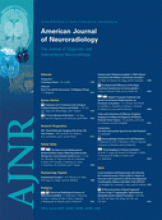Abstract
BACKGROUND AND PURPOSE: The “ivy” sign that is identified on FLAIR images in patients with Moyamoya disease is considered to be leptomeningeal collaterals. The aim of our study was to evaluate the correlation between postoperative decrease in ivy sign and cerebral hemodynamic status in the bypass-established hemisphere.
MATERIALS AND METHODS: Twenty-two patients with Moyamoya disease were enrolled. Postoperative changes in the ivy sign on FLAIR images were examined in each patient after bypass surgery. The correlation between postoperative changes in the ivy sign and hemodynamic status was examined in 10 patients by using SPECT.
RESULTS: Of the 22 preoperative ivy-positive patients, 21 showed decreased ivy signs on the operative side. Average intervals between the operation day and the date when the decreased or vanished ivy sign was first recognized were 157.6 days in patients who underwent direct bypass and 212.2 days in patients who underwent indirect bypass. A postoperative decrease in ivy signs was found to be significantly correlated with an improved hemodynamic status of the surgically treated hemisphere, resulting in a postoperative increase in regional vascular reserve and a decreased proportion of the misery perfusion area (P < .01).
CONCLUSIONS: Postoperative changes in the ivy sign can be used as a marker for identifying improved hemodynamics and also for testing the effectiveness of cerebral revascularization.
Abbreviations
- ACZ
- acetylzolamide
- CBF
- cerebral blood flow
- FLAIR
- fluid-attenuated inversion recovery
- Inf
- inferior
- 123I-IMP
- iodine-123-N-isopropyl-p-iodoamphetamine
- IV
- intravenous
- JET
- Japanese Extracranial-Intracranial Bypass Trial
- L
- left
- Lt La
- left lateral
- MCA
- middle cerebral artery
- MRA
- MR angiography
- MRI
- MR imaging
- PET
- positron-emission tomography
- postope.
- postoperative
- preope.
- preoperative
- R
- right
- Rt Lat
- right lateral
- STA-MCA
- superficial temporal artery−middle cerebral artery
- rCBF
- regional CBF
- Rest
- resting
- rVR
- regional VR
- SPECT
- single-photon emission CT
- Sup
- superior
- VR
- vascular reserve
- Copyright © American Society of Neuroradiology












